Boykoff, M. T. (2013), Public Enemy No. 1? Understanding Media Representations of Outlier Views on Climate Change. American Behavioral Scientist, March 1. [pdf].
 Abstract: Outlier voices—particularly those views often dubbed climate “skeptics,” “denialists,” or “contrarians”—have gained prominence and traction in mass media over time through a mix of internal workings such as journalistic norms, institutional values and practices, and external political, economic, cultural, and social factors. In this context, the article explores how and why these actors—through varied interventions and actions—garner disproportionate visibility in the public arena via mass media. It also examines how media content producers grapple with ways to represent claims makers, as well as their claims, so that they clarify rather than confuse these critical issues. Read more ... Abstract: Outlier voices—particularly those views often dubbed climate “skeptics,” “denialists,” or “contrarians”—have gained prominence and traction in mass media over time through a mix of internal workings such as journalistic norms, institutional values and practices, and external political, economic, cultural, and social factors. In this context, the article explores how and why these actors—through varied interventions and actions—garner disproportionate visibility in the public arena via mass media. It also examines how media content producers grapple with ways to represent claims makers, as well as their claims, so that they clarify rather than confuse these critical issues. Read more ...
Dilling, L., R. Birdsey, and Y. Pan (2013), Chapter 18: Opportunities and Challenges for Carbon Management on U.S. Public Lands. Invited Contribution for Land Use and the Carbon Cycle: Science and Applications in Human and Environment Interactions. Robinson, Brown, French and Reed, Eds. Cambridge University Press.
O’Neill, S. J., M. Boykoff, S. Niemeyer, and S. A. Day (2013), On the Use of Imagery for Climate Change Engagement. Global Environmental Change. [pdf].
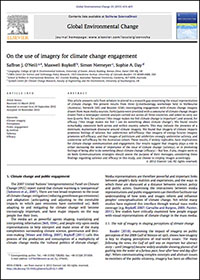 Abstract: This article answers calls from scholars to attend to a research gap concerning the visual representation of climate change. We present results from three Q-methodology workshops held in Melbourne (Australia), Norwich (UK) and Boulder (USA) investigating engagement with climate change imagery drawn from mass media sources. Read more ... Abstract: This article answers calls from scholars to attend to a research gap concerning the visual representation of climate change. We present results from three Q-methodology workshops held in Melbourne (Australia), Norwich (UK) and Boulder (USA) investigating engagement with climate change imagery drawn from mass media sources. Read more ...
Pielke, Jr., R. A. (2013), How can FIFA be held accountable? Sport Management Review. [pdf].
 Abstract: The Fédération Internationale de Football Association, or FIFA, is a non-governmental organization located in Switzerland that is responsible for overseeing the quadrennial World Cup football (soccer) competition in addition to its jurisdiction over other various international competitions and aspects of international football. The organization, long accused of corruption, has in recent years been increasingly criticized by observers and stakeholders for its lack of transparency and accountability. In 2011 FIFA initiated a governance reform process which will come to a close in May 2013. This paper draws on literature in the field of international relations to ask and answer the question: how can FIFA be held accountable? Read more ... Abstract: The Fédération Internationale de Football Association, or FIFA, is a non-governmental organization located in Switzerland that is responsible for overseeing the quadrennial World Cup football (soccer) competition in addition to its jurisdiction over other various international competitions and aspects of international football. The organization, long accused of corruption, has in recent years been increasingly criticized by observers and stakeholders for its lack of transparency and accountability. In 2011 FIFA initiated a governance reform process which will come to a close in May 2013. This paper draws on literature in the field of international relations to ask and answer the question: how can FIFA be held accountable? Read more ...
Pielke, Jr., R. A. (2013), Dear Expert, Please Cook the Books. Wall Street Journal January 29. [pdf].
 Excerpt: Last week the Greek government brought charges against Andreas Georgiou, the head of its independent statistical agency Elstat, and two of his colleagues for allegedly overstating the country’s 2009 debt. The debt calculations were a critical factor in characterizing the magnitude of the nation’s financial crisis and the subsequent responses by the European Union and the International Monetary Fund. For his part, Mr. Georgiou complained after the investigation began: “I am being prosecuted for not cooking the books.” By contrast, Greek politicians have argued that the statistical agency was working counter to national interests. One politician said that Elstat was “too focused on the numbers and not enough on serving the country and the government.” This situation is but one of a growing number of recent conflicts found where expertise meets politics. Read more ... Excerpt: Last week the Greek government brought charges against Andreas Georgiou, the head of its independent statistical agency Elstat, and two of his colleagues for allegedly overstating the country’s 2009 debt. The debt calculations were a critical factor in characterizing the magnitude of the nation’s financial crisis and the subsequent responses by the European Union and the International Monetary Fund. For his part, Mr. Georgiou complained after the investigation began: “I am being prosecuted for not cooking the books.” By contrast, Greek politicians have argued that the statistical agency was working counter to national interests. One politician said that Elstat was “too focused on the numbers and not enough on serving the country and the government.” This situation is but one of a growing number of recent conflicts found where expertise meets politics. Read more ...
Pielke, Jr., R. A. (2013), Letter from America: a memo to chief scientific adviser Sir Mark Walport. The Guardian, April 15. [pdf].
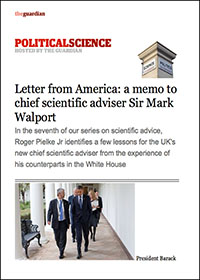 Excerpt: Congratulations Dr Walport on your appointment as the UK government’s chief scientific adviser. You join a select group. Since the position of chief science adviser was established in the US in 1957 and in the UK in 1964, fewer than 30 men (yes, all men) have occupied the position. Today across Europe, only Ireland, the Czech Republic and the European Commission have formal equivalents, which also exist in Australia, New Zealand, and soon perhaps in Japan and at the United Nations. Excerpt: Congratulations Dr Walport on your appointment as the UK government’s chief scientific adviser. You join a select group. Since the position of chief science adviser was established in the US in 1957 and in the UK in 1964, fewer than 30 men (yes, all men) have occupied the position. Today across Europe, only Ireland, the Czech Republic and the European Commission have formal equivalents, which also exist in Australia, New Zealand, and soon perhaps in Japan and at the United Nations.
In the United States, the science adviser is an assistant to the president with the formal title of Director of the Office of Science and Technology Policy. All US science advisers (except notably the first, James Killian, who had a background in public administration) have been trained in some area of physics, reflecting the cold war origins of the position.
Since 2005, the Centre for Science and Technology Policy Research at the University of Colorado has brought to our campus presidential science advisers, spanning the administrations of John F Kennedy to Barack Obama. Let me distil what I consider to be a few of the most relevant insights from their experiences. Read more ...
|
Pielke, Jr., R. A. (2013), Why Monbiot’s attack on Walport misses the mark, The Guardian, April 30. [read online].
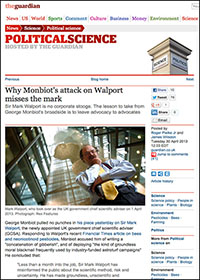 Excerpt: George Monbiot pulled no punches in his piece yesterday on Sir Mark Walport, the newly appointed UK government chief scientific adviser (GCSA). Responding to Walport’s recent Financial Times article on bees and neonicotinoid pesticides, Monbiot accused him of writing a “concatenation of gibberish”, and of deploying “the kind of groundless moral blackmail frequently used by industry-funded astroturf campaigns” He concluded that: Excerpt: George Monbiot pulled no punches in his piece yesterday on Sir Mark Walport, the newly appointed UK government chief scientific adviser (GCSA). Responding to Walport’s recent Financial Times article on bees and neonicotinoid pesticides, Monbiot accused him of writing a “concatenation of gibberish”, and of deploying “the kind of groundless moral blackmail frequently used by industry-funded astroturf campaigns” He concluded that:
"Less than a month into the job, Sir Mark Walport has misinformed the public about the scientific method, risk and uncertainty. He has made groundless, unscientific and emotionally manipulative claims. He has indulged in scaremongering and wild exaggeration in support of the government’s position.”
Do tell us how you really feel, George. Read more ...
Pielke, Jr., R. A. (2013), No, Europe’s ETS definitely doesn’t work. Lowy Institute for International Policy, The Interpreter, April 30. [read online].
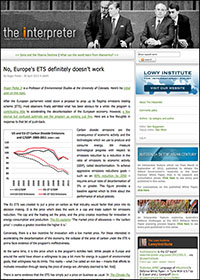 Excerpt: After the European parliament voted down a proposal to prop up its flagship emissions trading scheme (ETS), most observers finally admitted what has been obvious for a while: the program is contributing little to accelerating the decarbonisation of the European economy. However, a few eternal but confused optimists see the program as working just fine. Here are a few thoughts in response to that bit of push-back. Read more ... Excerpt: After the European parliament voted down a proposal to prop up its flagship emissions trading scheme (ETS), most observers finally admitted what has been obvious for a while: the program is contributing little to accelerating the decarbonisation of the European economy. However, a few eternal but confused optimists see the program as working just fine. Here are a few thoughts in response to that bit of push-back. Read more ...
Sarewitz, D. and R.A. Pielke, Jr. (2013), Learning to Live With Fossil Fuels, The Atlantic, May. [read online].
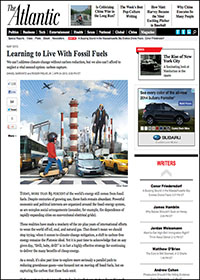 Excerpt: Today, more than 85 percent of the world’s energy still comes from fossil fuels. Despite centuries of growing use, these fuels remain abundant. Powerful economic and political interests are organized around the fossil-energy system, as are complex social arrangements (consider, for example, the dependence of rapidly expanding cities on conventional electrical grids). Excerpt: Today, more than 85 percent of the world’s energy still comes from fossil fuels. Despite centuries of growing use, these fuels remain abundant. Powerful economic and political interests are organized around the fossil-energy system, as are complex social arrangements (consider, for example, the dependence of rapidly expanding cities on conventional electrical grids).
These realities have made a mockery of the 20-plus years of international efforts to wean the world off oil, coal, and natural gas. That doesn’t mean we should stop trying; when it comes to climate-change mitigation, a shift to carbon-free energy remains the Platonic ideal. Yet it is past time to acknowledge that on any given day, “Drill, baby, drill!” is in fact a highly effective strategy for continuing to deliver the many benefits of cheap energy.
As a result, it’s also past time to explore more seriously a parallel path to reducing greenhouse gases—one focused not on moving off fossil fuels, but on capturing the carbon that these fuels emit... Read more ...
Assessment of Climate Change in the Southwest United States [website].
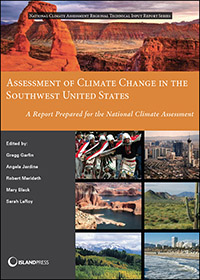 Excerpt: A hotter future is projected for the Southwestern United States—a region stretching from the California coast to the plains of eastern Colorado and New Mexico—and future heat and changes in precipitation will present challenges for managing natural resources, water, infrastructure and threats to human health. Read more about this report in our Center News section. Download the full pdf. Excerpt: A hotter future is projected for the Southwestern United States—a region stretching from the California coast to the plains of eastern Colorado and New Mexico—and future heat and changes in precipitation will present challenges for managing natural resources, water, infrastructure and threats to human health. Read more about this report in our Center News section. Download the full pdf.
|










